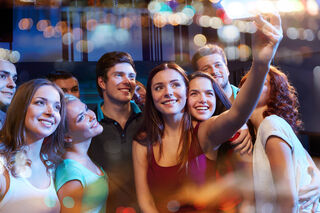Mating
Who Would You Date on Instagram?
Do group photos and the perception of popularity influence dating prospects?
Posted May 28, 2021 Reviewed by Abigail Fagan
Key points
- The decision to date may be influenced by the types of photos people post and view, and their own personality.
- Selfies and group photos tend to be judged as more narcissistic than neutral photos.
- Men with a high need for popularity may be less attracted to popular women. Women may be more attracted to popular men.

As you look through Instagram, have you ever considered what the person you are looking at is really like? Can you tell this from the type of photos they post? For example, is a person narcissistic because they post lots of selfies? Are they sociable and outgoing if they post lots of group photos or photos with other people? Furthermore, would the type of photographs they post influence your decision to date them?
In one study, Venus Jin and colleagues investigated how four different types of Instagram photos (selfies, group photos, long shot photos and neutral photos), might influence people's decision to date the person posting the photo (Jin, Ryu, & Muqaddam, 2019).
They also investigated whether people's decision to date might not only be influenced by the types of photos they view, but also by their own personality in terms of the four elements outlined below.
First, are we driven by rivalry with other members of the same sex in the pursuit of a romantic partner, known as intrasexual competition? For example, men high in terms of intrasexual competition may be motivated to pursue more attractive women than men lower on measures of intrasexual competition.
Second, how concerned are we about being popular? Some people are driven by a need to attract as many social media followers as possible and collect as many likes as possible to appear popular. Indeed, popular men are generally perceived to be more attractive because popularity is generally associated with access to resources such as wealth.
Third, do we have a need to belong, in terms of group membership? Generally, most of us have a desire for affiliation and a desire to connect with others and this generally increases our levels of life satisfaction.
Fourth, how lonely do we normally feel? Lonely people may experience more anxiety in pursuing romantic relationships because of the fear of rejection and therefore may only select safer choices as potential dates.
The participants in the study of Venus Jin and colleagues were assigned to one of four different conditions and presented with the following types of photos. Heterosexual female participants were presented with male photos and heterosexual male participants presented with female photos.
- Selfies (defined as close-up photos taken with a handheld smartphone).
- Groupies (close-up group selfie-type photos featuring the target and a member of the opposite sex).
- Long shot photos (full length photos taken by another person).
- Neutral photos (photos without the presence of the target person and which depicted neutral objects)
The participants initially gave ratings of narcissism for the person in the photograph (he or she likes to be the centre of attention, he or she likes to show off his or her body). They then completed the Dating Desire Scale (How interested would you be in dating this person? Would you like to go out on a date with this person? How appealing do you find this person as a romantic partner?).
Participants then completed measures of:
- Intrasexual competition — I work out, exercise, or watch what I eat because I want a body that will impress potential romantic partners. I prefer to go out to clubs with same sex friends who are less attractive than I am.
- The need for popularity — It’s important that people think I’m popular, I often do things just to be popular with people.
- Needing to belong — I want other people to accept me, It bothers me a great deal when I am not included in other people’s plans.
- Loneliness — How often do you feel alone? How often do you feel isolated from others?
How Personality Traits Predicted Dating Choices
First, the researchers found that selfies and group photos were judged by the participants to be more narcissistic in comparison to neutral photos.
In terms of the four personality traits of the participants, the researchers found that for men, those with a higher need for popularity, higher need for belonging and higher loneliness score indicated a greater intention to date female Instagram users who posted neutral photos. These men also indicated a lower intention to date women who posted group photos on Instagram than men with a lower need for popularity, lower need to belong and lower loneliness scores.
Men with a high need for popularity may be less attracted to women showing themselves to be popular by posting group photos, because this detracts from their own popularity. Instead, because neutral photos were rated as lowest in terms of narcissism, men with a higher score on the need for popularity were more inclined to want to date the people in these photos.
Women with higher scores on intrasexual competition, the need to belong, the need for popularity and loneliness, indicated a greater desire to date men who posted group photographs. This may be explained by the evolutionary principle that women may be more attracted to men with status (popularity) as indicated by men posting group photos. Furthermore, women may perceive males with friends as being more trustworthy, which in turn makes them more attractive.
Overall, men with higher intrasexual competition scores indicated higher dating intentions for all types of Instagram photo, possibly suggesting that these men are unbothered about the type of person they choose to date at least in the short term. A further explanation is that these men are also undeterred by competition from other men, who might be present in group photos.
However, men with lower intrasexual competition scores were influenced by the type of photos they viewed. These men indicated a higher desire to date sociable women (indicated in group photos) and indicated a lower desire to date women who were less sociable (indicated in the neutral photos).
One avenue of future research would be to look at the different types of dating intentions of those viewing Instagram photos, for example whether they may be seeking short or longer-term relationships. Nevertheless, this study provides insight into which profile pictures influence the desire to date as well as how the personality of the person selecting a date has an impact.
References
Jin, S. V., Ryu, E. & Muqaddam, A. (2019) ‘Romance 2.0 on Instagram! “What Type of Girlfriend Would You Date?”’ Evolutionary Psychology, 1-7.




